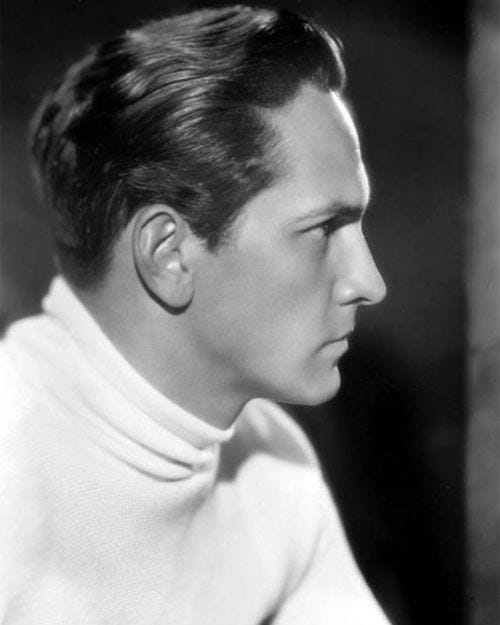FREDDIE

Fredric March was born 124 years ago today; an actor whose final Broadway appearance was in 1962’s Gideon, by Paddy Chayefsky. Fifty-nine years is a long time and there are not many around anymore who can recall March’s sterling stage work in a career that spanned forty-two years on Broadway. But due to his more than eighty films between 1929 and 1973, his legacy is secure as an actor of wide-ranging skill. I was first exposed to him as a kid when I became obsessed with the 1960 film version of the Jerome Lawrence and Robert E. Lee stage play Inherit the Wind, which I would watch as often as I could on my parents’ old black and white TV. I didn’t know who March was, but I was instantly taken with someone who could go toe to toe with that grand old man, Spencer Tracy, easily my favorite old-time movie star back in the day.

Over the years, I expanded my March Madness and fell in love with the Wisconsin born actor, who seemingly never turned down a challenge. Except for musicals, nothing was off limits. He excelled at light comedy in such films as Nothing Sacred and I Married a Witch, opposite Carole Lombard, and Veronica Lake, respectively. He effortlessly channeled John Barrymore and Errol Flynn in the films The Royal Family and The Buccaneer, swaggering and swashbuckling in as romantic and charismatic a fashion as either of them. He portrayed noteworthy literary characters in adaptations of classic novels like Jean Valjean in Les Misérables, opposite the Javert of Charles Laughton, and Count Vronsky to Greta Garbo’s Anna Karenina. And, in addition to Inherit the Wind, starred in the film versions of plays as varied as Noël Coward’s Design for Living, Paddy Chayefsky’s Middle of the Night and Arthur Miller’s Death of a Salesman. But his crowning achievement was his Oscar winning performance in 1946’s The Best Years of Our Lives, as a returning World War II vet. Under William Wyler’s direction of a tender and touching screenplay by Robert E. Sherwood, it is a film for the ages. At its center is March, whose performance brings together all the things that made him such a fine actor: a marvelous listener, commanding, when necessary, fiercely comical (his drunk work in the film is better than excellent) and even shyness and vulnerability. His scene with Myrna Loy where he doesn’t know how to begin to reconnect sexually with a wife he loves with all his heart and soul, is a killer.

As a young man starting out, his good looks took him far quickly, but he transcended being just another pretty face relatively early in his film career, when at age thirty-four, he took on the title roles in the first talking version of Dr. Jekyll and Mr. Hyde (for which he won the first two of his Academy Awards). The makeup devised for his Mr. Hyde so terrified me as a child, that to this day I have never watched the film. My father told me that as a small boy (age seven when the film came out), he hid under the seat in his local Brooklyn movie house, which I’m sure added to my general terror. I mean, if my father couldn’t take it, how was I supposed to manage? Judge for yourself. It’s not a pretty picture.

Born on this date in 1897 as Frederick McIntyre Bickel, March worked as a bank teller while still a teenager and attended the University of Wisconsin where he studied economics. His military service coincided with the tail end of World War I, and when he arrived in New York City in 1919 it was with the intention of becoming a banker, not an actor. Even though he had played leads at Madison and had been a champion college debater, he didn’t quite feel he could make a living at acting. This despite earning money as a part‐time magazine model (though that’s not really acting).
He eventually made his Broadway debut at age twenty-three in a play called Deburau, where he used his real name of Frederick Bickel. Two other plays followed until 1923 when he took on the name Frederic March. He appeared in purely unsubstantial plays for several years and started making early talking pictures as early as 1929. He got his first Academy Award nomination in 1931 for the screen adaptation of the George S. Kaufman and Edna Ferber hit The Royal Family of Broadway and went on to win the next year for Dr. Jekyll and Mr. Hyde. He finally had a prestige hit on Broadway in 1939 when he starred in George S. Kaufman and Moss Hart’s The American Way, opposite his wife Florence Eldridge, whom he married in 1927. Frankly, “prestige” isn’t enough to pay the overhead when audiences don’t come to a production with a cast of 206–which is QUITE the overhead. The American Way’s three-month run was a disappointment, to say the least.
In 1947, March was the recipient of the very first Tony for Best Actor in a Play, sharing the award with Jose Ferrer for his Cyrano de Bergerac (with no nominees in the first few years, it was not uncommon for there to be more than one winner). This first Tony was for March’s performance in the actress-playwright Ruth Gordon’s autobiographical play Years Ago. March then took home a second Tony in 1957, when he created the role of James Tyrone in Eugene O’Neill’s epic Long Day’s Journey into Night. Interesting fact: March is the only male actor to have won both the Academy Award and the Tony Award twice (Helen Hayes is the female).
As Mary Tyrone, March once again co-starred with Florence Eldridge. Having performed in numerous plays and films together, including the original production of Thornton Wilder’s The Skin of Our Teeth, the O’Neill play was a tremendous challenge for the Marches, ultimately providing career triumphs for them both.

March worked hard at his chosen profession (or did it choose him?). He liked to tell the story of one of his earliest acting teachers at the American Academy of Dramatic Arts, Madame Eva Alberti, who told him, “Son, if you don’t come off the stage feeling you want to go right back on again and do it better, there’s something wrong.” His having spent so many years working in the theatre, I found this interesting quote from March, that goes against how most actors feel about sustaining a long run (he did Long Day’s Journey for two years — and it’s a loooong play): “There are advantages in being in a long run,” he said. “You should see plays after they’ve been around for a while if you want to see the best performances … The actors are more relaxed in their parts.”
His final film was again a chance to lock in a great stage character for posterity, as well as return to Eugene O’Neill. His Harry Hope in John Frankenheimer’s 1973 film of The Iceman Cometh wound up as one of his best. “What did you do to the booze, Hickey?” cries Hope, confused and tormented by Theodore Hickman, his one-time friend who demands out of the blue that he and all the denizens of Hope’s seedy waterfront salon look past their pipe dreams and open their eyes to reality: one that is profoundly not within their grasp. March finds ways in the role to be clownish, frightened, proud, dim-witted and shrewd on yet another grueling long day’s journey.

In 1975, Fredric March died at age seventy-seven from prostate cancer. His wife survived him, and when she died thirteen years later, she was interred next to him on the grounds of an estate they owned in New Milford, Connecticut. Nearby stands the Merryall Arts Center, which in 1952, was purchased by the Marches (along with a group of other homeowners) on the land where an old farm had once stood. They converted the barn into a performing arts center which is still standing today (inoperational at present due to Covid), where concerts are given bringing arts and culture to this once sleepy rural community.
So, on this anniversary of his birth, a thank you to Fredric March for not only the legacy of the great performances he left behind, but for helping provide a home for new artists to practice their craft that carries on in his memory.

If you enjoy these columns, check out Up in the Cheap Seats: A Historical Memoir of Broadway, available at Amazon.com in hardcover, softcover and e-book. Also, please follow me here on Medium and feel free to email me with comments or questions at Ron@ronfassler.org.
